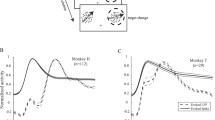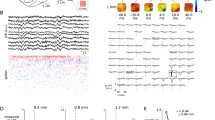Abstract
Multineuronal recordings have revealed that neurons in primary visual cortex (V1) exhibit coordinated fluctuations of spiking activity in the absence and in the presence of visual stimulation. From the perspective of understanding a single cell’s spiking activity relative to a behavior or stimulus, these network fluctuations are typically considered to be noise. We show that these events are highly correlated with another commonly recorded signal, the local field potential (LFP), and are also likely related to global network state phenomena which have been observed in a number of neural systems. Moreover, we show that attributing a component of cell firing to these network fluctuations via explicit modeling of the LFP improves the recovery of cell properties. This suggests that the impact of network fluctuations may be estimated using the LFP, and that a portion of this network activity is unrelated to the stimulus and instead reflects ongoing cortical activity. Thus, the LFP acts as an easily accessible bridge between the network state and the spiking activity.






Similar content being viewed by others
References
Abbott, L. F., & Dayan, P. (1999). The effect of correlated variability on the accuracy of a population code. Neural Computation, 11, 91–101.
Areili, A., Sterkin, A., Grinvald, A., & Aertson, A. (1996). Dynamics of ongoing activity: Explanation of the large variability in evoked cortical responses. Science, 273(5283), 1868–1871.
Averbeck, B. B., Latham, P. E., & Pouget, A. P. (2006). Neural correlations, population coding and computation. Nature Reviews. Neuroscience, 7, 358–366.
Bair, W., Zohary, E., & Newsome, W. T. (2001). Correlated firing in macaque visual area MT: Time scales and relationship to behavior. Journal of Neuroscience, 21, 1676–1697.
Berens, P., Keliris, G., Ecker, A., Logothetis, N., & Tolias, A. (2008). Feature selectivity of the gamma-band of the local field potential in primate primary visual cortex. Frontiers in Neuroscience, 2, 199–207.
Buzsaki, G. (2004). Large-scale recording of neuronal ensembles. Nature Neuroscience, 7, 446–451.
Cavanaugh, J. R., Bair, W., & Movshon, J. A. (2002). Nature and interaction of signals from the receptive field center and surround in macaque V1 neurons. Journal of Neurophysiology, 88, 2530–2546.
David, S., Vinje, W., & Gallant, J. (2004). Natural stimulus statistics alter the receptive field structure of V1 neurons. Journal of Neuroscience, 24, 6991–7006.
Destexhe, A., & Contreras, D. (2006). Neuronal computations with stochastic network states. Science, 314, 85–90.
DeValois, R. L., Albrecht, D. G., & Thorell, L. G. (1982). Spatial frequency selectivity of cells in macaque visual cortex. Vision Research, 22, 545–559.
Eggermont, J., & Smith, G. (1995). Synchrony between single-unit activity and local field potentials in relation to periodicity coding in primary auditory cortex. Journal of Neurophysiology, 73, 227–245.
Foster, K. H., Gaska, J. P., Nagler, M., & Pollen, D. A. (1985). Spatial and temporal frequency selectivity of neurones in visual cortical areas V1 and V2 of the Macaque monkey. Journal of Physiology, 365, 331–363.
Frien, A., Eckhorn, R., Bauer, R., Woelbern, T., & Gabriel, A. (2000). Fast oscillations display sharper orientation tuning than slower components of the same recordings in striate cortex of the awake monkey. European Journal of Neuroscience, 12, 1453–1465.
Gray, C. M., Maldonado, P. E., Wilson, M., & McNaughton, B. (1995). Tetrodes markedly improve the reliability and yield of multiple single-unit isolation from multi-unit recordings in cat striate cortex. Journal of Neuroscience Methods, 63, 43–54.
Hardin, J. W., & Hilbe, J. (2007). Generalized linear models and extensions. College Station: Stata.
Haslinger, R., Ulbert, I., Moore, C., Brown, E., & Devor, A. (2006). Analysis of LFP phase predicts sensort response of barrel cortex. Journal of Neurophysiology, 96, 1658–1663.
He, B., Snyder, A., Zempel, J., Smyth, M., & Raichle, M. (2008). Electrophysiological correlates of the brains intrinsic large-scale functional architecture. Proceedings of the National Academy of Sciences of the United States of America, 105, 16039–16044.
Henrie, J., & Shapley, R. (2005). LFP power spectra in V1 cortex: The graded effect of stimulus contrast. Journal of Neurophysiology, 94, 479–490.
Huang, X., & Lisberger, S. (2009). Noise correlations in cortical area MT and their potential impact on trial-by-trial variation in the direction and speed of smooth pursuit eye movements. Journal of Neurophysiology, 101, 3012–3030.
Johnson, H., & Buonomano, D. (2007). Development and plasticity of spontaneous activity and up states in cortical organotypic slices. Journal of Neuroscience, 27(22), 5915–5925.
Kass, R., & Ventura, V. (2001). A spike-train probability model. Neural Computation, 13, 1713–1720.
Katzner, S., Nauhaus, I., Benucci, A., Bonin, V., Ringach, D., & Carandini, M. (2009). Local origin of field potentials in visual cortex. Neuron, 61, 35–41.
Kelly, R. C., Smith, M. A., Samonds, J. M., Kohn, A., Bonds, A. B., Movshon, J. A., et al. (2007). Comparison of recordings from microelectrode arrays and single electrodes in the visual cortex. Journal of Neuroscience, 27, 261–264.
Kohn, A., & Smith, M. A. (2005). Stimulus dependence of neuronal correlation in primary visual cortex of the Macaque. Journal of Neuroscience, 25, 3661–3673.
Kohn, A., Zandvakili, A., & Smith, M. A. (2009). Correlations and brain states: From electrophysiology to functional imaging. Current Opinion in Neurobiology, 19, 434–438.
Körding, K., Kayser, C., Einhäuser, W., & König, P. (2004). How are complex cell properties adapted to the statistics of natural stimuli? Journal of Neurophysiology, 91, 206–212.
Kreiman, G., Hung, C., Kraskov, A., Quiroga, R., Poggio, T., & DiCarlo, J. (2006). Object selectivity of local field potentials and spikes in the Macaque inferior temporal cortex. Neuron, 49, 433–445.
Kruse, W., & Eckhorn, R. (1996). Inhibition of sustained gamma oscillations (35–80 Hz) by fast transient responses in cat visual cortex. Proceedings of the National Academy of Sciences, 93, 6112–6117.
Lampl, I., Reichova, I., & Ferster, D. (1999). Synchronous membrane potential fluctuations in neurons of the cat visual cortex. Neuron, 22, 361–374.
Legatt, A. D., Arezzo, J., & Vaughan, H. G. (1980). Averaged multiple unit activity as an estimate of phasic changes in local neuronal activity: Effects of volume-conducted potentials. Journal of Neuroscience Methods, 2, 203–217.
Leopold, D. A., Murayama, Y., & Logothetis, N. K. (2003). Very slow activity fluctuations in monkey visual cortex: Implications for functional brain imaging. Cerebral Cortex, 13, 422–433.
Liu, J., & Newsome, W. (2006). Local field potential in cortical area MT: Stimulus tuning and behavioral correlations. Journal of Neuroscience, 26, 7779–7790.
Luczak, A., Bartho, P., Marguet, S., Buzsaki, G., & Harris, K. (2007). Sequential structure of neocortical spontaneous activity in vivo. Proceedings of the National Academy of Sciences of the United States of America, 104, 347–352.
Mitzdorf, U. (1987). Properties of the evoked potential generators: Current source-density analysis of visually evoked potentials in the cat cortex. International Journal of Neuroscience, 33, 33–59.
Nauhaus, I., Busse, L., Carandini, M., & D.L., R. (2009). Stimulus contrast modulates functional connectivity in visual cortex. Nature Neuroscience, 12, 70–76.
Nir, Y., Mukamel, R., Dinstein, I., Privman, E., Harel, M., Fisch, L., et al. (2008). Interhemispheric correlations of slow spontaneous neuronal fluctuations revealed in human sensory cortex. Nature Neuroscience, 11(9), 1100–1108.
Paninski, L. (2004). Maximum likelihood estimation of cascade point-process encoding models. Network: Computation in Neural Systems, 15, 243–262.
Paninski, L., Brown, E., Iyengar, S., & Kass, R. (2009). Statistical models of spike trains. In C. Liang, & G. Lord (Eds.), Stochastic methods in neuroscience (pp. 278–303). Oxford: Clarendon.
Paninski, L., Pillow, J., & Lewi, J. (2007). Statistical models for neural encoding, decoding, and optimal stimulus design. Progress in Brain Research, 165, 493.
Petersen, C., Grinvald, A., & Sakmann, B. (2003). Spatiotemporal dynamics of sensory responses in layer 2/3 of rat barrel cortex measured in vivo by voltage-sensitive dye imaging combined with whole-cell recordings and neuron reconstructions. Journal of Neuroscience, 23, 1298–1309.
Pillow, J. (2007). Likelihood-based approaches to modeling the neural code. In K. Doya, S. Ishii, A. Pouget, & R. Rao, (Eds.), Bayesian brain: Probabilistic approaches to neural coding (pp. 53–70). Cambridge: MIT.
Pillow, J., & Latham, P. (2008). Neural characterization in partially observed populations of spiking neurons. Advances in Neural Information Processing Systems, 20, 1161–1168.
Pillow, J., Shlens, J., Paninski, L., Sher, A., Litke, A., Chichilnisky, E., et al. (2008). Spatio-temporal correlations and visual signalling in a complete neuronal population. Nature, 454, 995–999.
Rasch, M., Gretton, A., Murayama, Y., Maass, W., & Logothetis, N. (2008). Inferring spike trains from local field potentials. Journal of Neurophysiology, 99, 1461–1476.
Ringach, D., Hawken, M., & Shapley, R. (2002). Receptive field structure of neurons in monkey primary visual cortex revealed by stimulation with natural image sequences. Journal of Visualization, 2, 12–24.
Rousche, P. J., & Normann, R. A. (1992). A method for pneumatically inserting an array of penetrating electrodes into cortical tissue. Annals of Biomedical Engineering, 20, 413–422.
Samonds, J. M., & Bonds, A. B. (2005). Gamma oscillation maintains stimulus structure-dependent synchronization in cat visual cortex. Journal of Neurophysiology, 93, 223–236.
Shadlen, M. N., & Newsome, W. T. (1998). The variable discharge of cortical neurons: Implications for connectivity, computation, and information coding. Journal of Neuroscience, 18, 3870–3896.
Shlens, J., Field, G., Gauthier, J., Greschner, M., Sher, A., Litke, A., & Chichilnisky, E. (2009). The structure of large-scale synchronized firing in primate retina. Journal of Neuroscience, 29, 5022–5031.
Shoham, S., Fellows, M., & Normann, R. (2003). Robust, automatic spike sorting using mixtures of multivariate t-distributions. Journal of Neuroscience Methods, 127, 111–122.
Siegel, M., & Koenig, P. (2003). A functional gamma-band defined by stimulus-dependent synchronization in area 18 of awake behaving cats. Journal of Neuroscience, 23, 4251–4260.
Smith, M. A., Bair, W., & Movshon, J. A. (2002). Signals in macaque V1 neurons that support the perception of Glass patterns. Journal of Neuroscience, 22, 8334–8345.
Smith, M. A., & Kohn, A. (2008). Spatial and temporal scales of neuronal correlation in primary visual cortex. Journal of Neuroscience, 28, 12591–12603.
Tsodyks, M., Kenet, T., Grinvald, A., & Arieli, A. (1999). Linking spontaneous activity of single cortical neurons and the underlying functional architecture. Science, 286(5446), 1943–1946.
Xing, D., Yeh, C., & Shapley, R. (2009). Spatial spread of the local field potential and its laminar variation in visual cortex. Journal of Neuroscience, 29, 11540–11549.
Zohary, E., Shadlen, M. N., & Newsome, W. T. (1994). Correlated neuronal discharge rate and its implications for psychophysical performance. Nature, 370, 140–143.
Acknowledgements
This work was supported by a National Science Foundation (NSF) Integrative Graduate Education and Research Traineeship to RCK (DGE-0549352), National Eye Institute (NEI) grants EY015958 and EY018894 to MAS, National Institute of Mental Health (NIMH) Grant MH64445 and NSF CISE IIS 0713206 to TSL, and NIMH grant MH064537 to REK. Data was collected by RCK, MAS and Adam Kohn in his laboratory as a part of a collaborative effort between the Kohn laboratory at Albert Einstein College of Medicine and the Lee laboratory at Carnegie Mellon University. We thank Adam Kohn for collaboration, and we are also grateful to Amin Zandvakili, Xiaoxuan Jia and Stephanie Wissig for assistance in data collection.
Author information
Authors and Affiliations
Corresponding author
Additional information
Action Editor: Alain Destexhe
Rights and permissions
About this article
Cite this article
Kelly, R.C., Smith, M.A., Kass, R.E. et al. Local field potentials indicate network state and account for neuronal response variability . J Comput Neurosci 29, 567–579 (2010). https://doi.org/10.1007/s10827-009-0208-9
Received:
Revised:
Accepted:
Published:
Issue Date:
DOI: https://doi.org/10.1007/s10827-009-0208-9




